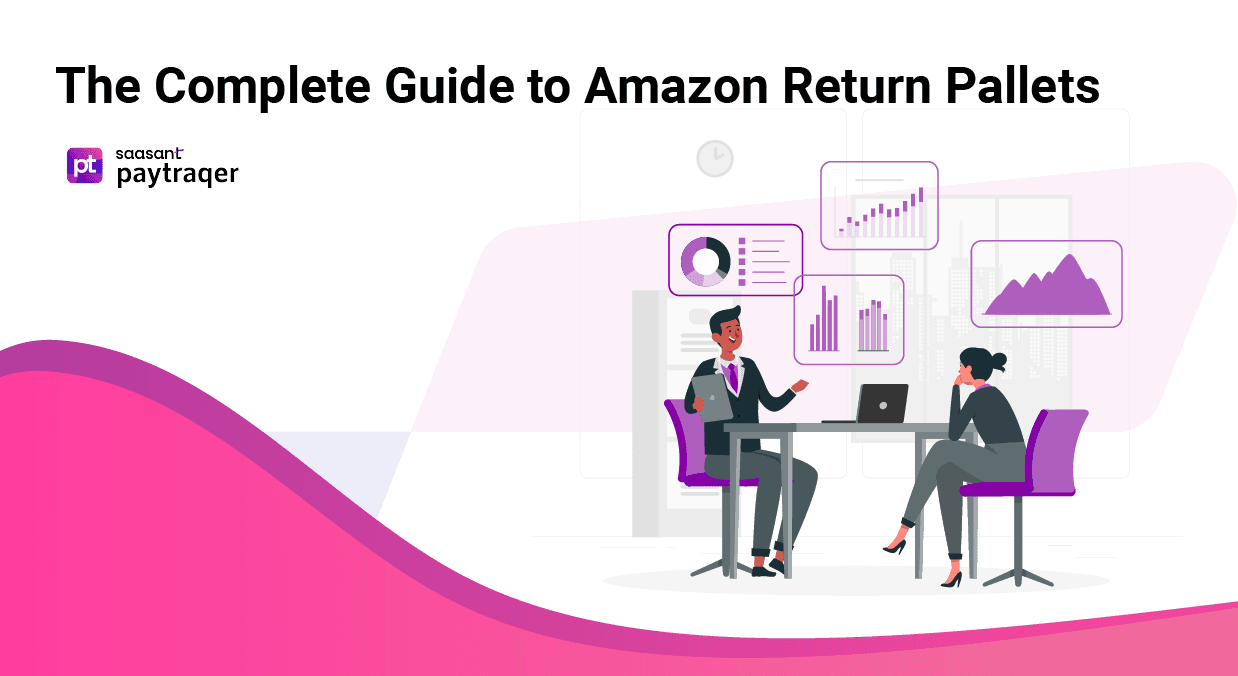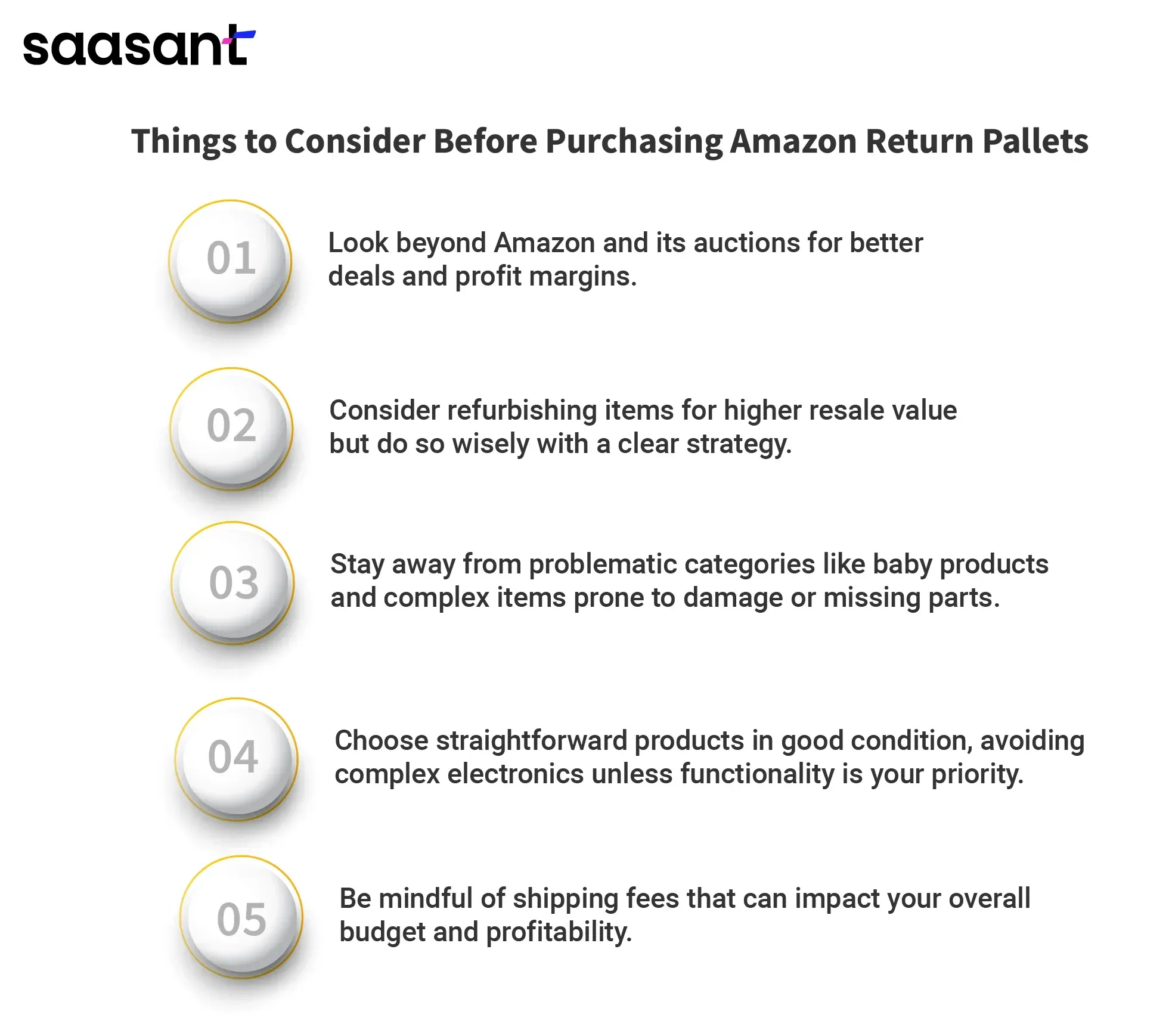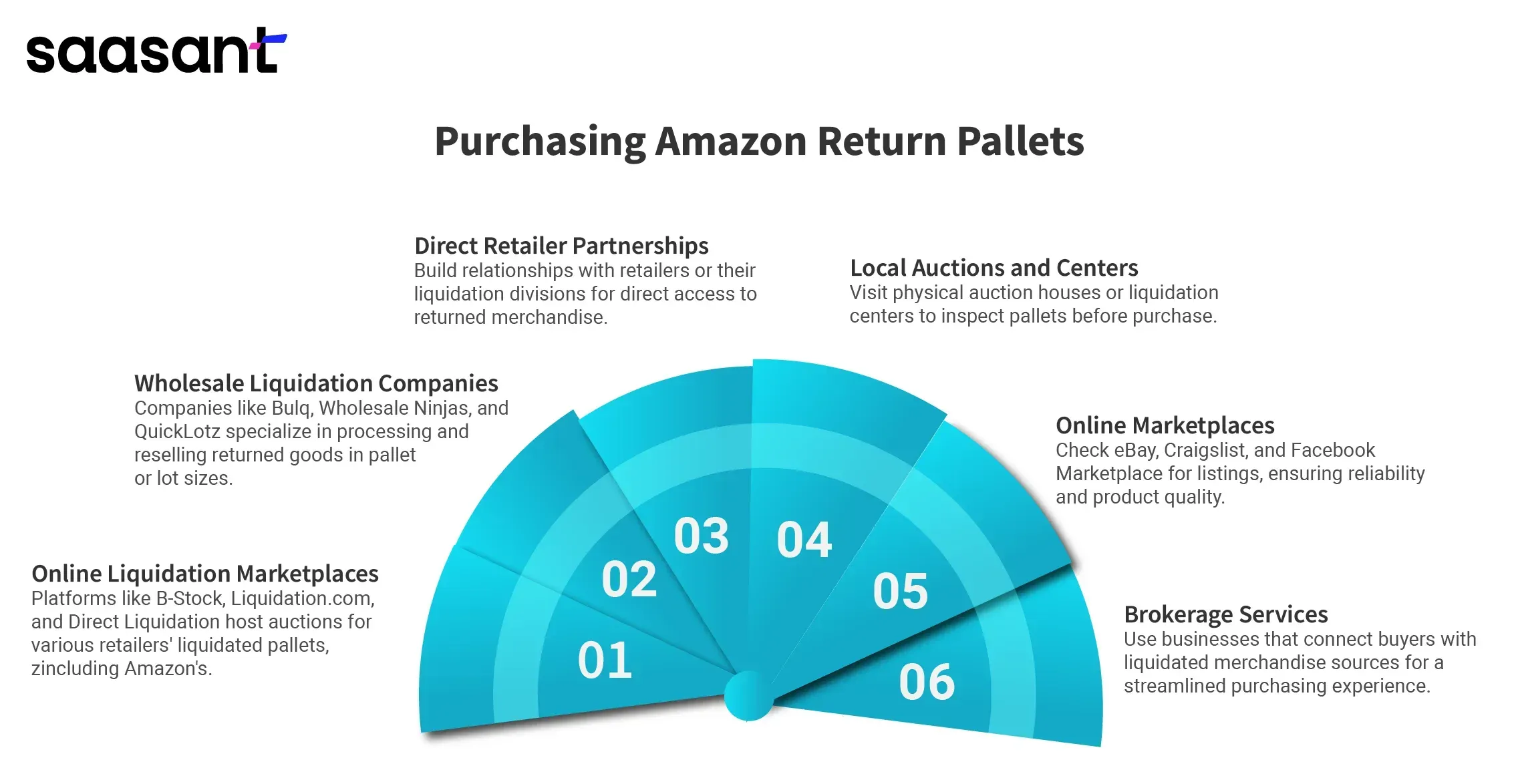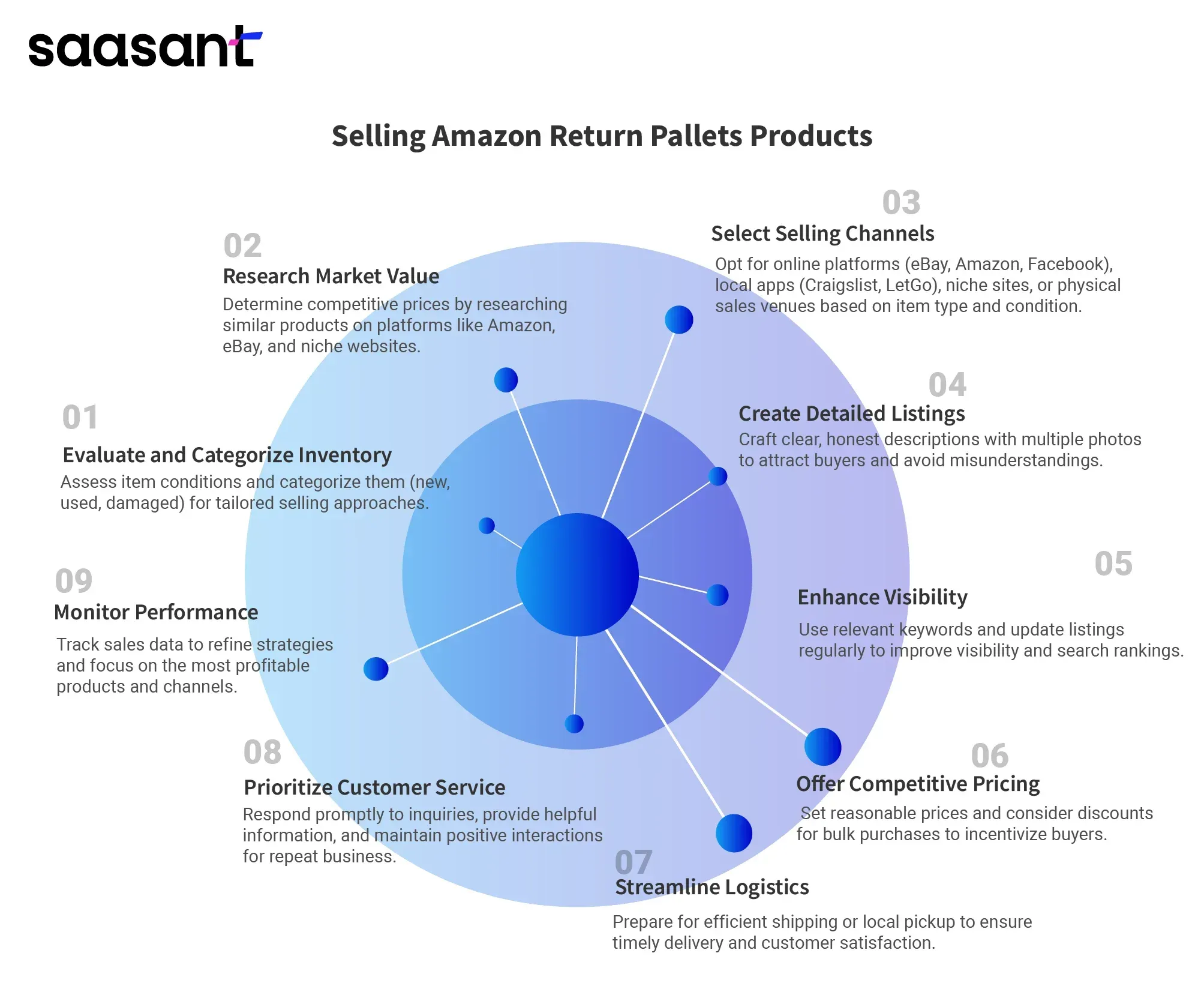Amazon Return Pallets: Complete Guide on Purchasing & Selling

Have you ever wondered what happens to the millions of products returned to Amazon annually? Instead of sending them back to sellers, Amazon sells them to third-party buyers at discounted rates. These are what we call Amazon return pallets. These pallets contain various items, including electronics, appliances, clothing, and toys. This is one of the exciting opportunities for wholesale sellers to purchase products at low cost and sell at high prices.
The blog will also explain Amazon return pallets, the types of products included in them, things to consider when purchasing products from Amazon return pallets, and much more.
Contents
What Are Amazon Return Pallets?
Things to Consider Before Purchasing Amazon Return Pallets
How to Purchase Amazon Return Pallets?
How to Sell Amazon Return Pallets Products?
Pros and Cons of Selling Amazon Return Pallets
Tips for Selling Amazon Return Pallets
Conclusion
FAQs
What Are Amazon Return Pallets?
Amazon return pallets are products returned to Amazon by customers due to various reasons, including damaged packaging, buyer’s remorse, or defects. These pallets usually include multiple products across categories like electronics, clothing, toys, and household goods.
When items are returned, Amazon investigates their condition. If they look good enough to be sellable, they might be repackaged and sold at a discount under 'Amazon Warehouse Deals.' However, items with minor defects or damages that prevent them from being sold as new are grouped into pallets. These pallets are then sold to liquidation companies or wholesalers dealing with such merchandise.
Amazon sells the pallets to buyers interested in purchasing large volumes of items at low prices. However, buying products from pallets has its risks, as the quality of items can greatly vary. Also, there's a higher chance of receiving defective or unsellable products than purchasing new goods directly from manufacturers or distributors.
Things to Consider Before Purchasing Amazon Return Pallets
Amazon Return Pallets can be the best resale opportunity if you navigate the process and avoid common pitfalls. Here are some considerations to keep in mind when purchasing Amazon Return Pallets:
Compare Liquidation Platforms
Buying directly from Amazon or through Amazon Liquidation Auctions can be cost-effective, as these platforms are highly competitive. Exploring other top liquidation companies can provide you with more opportunities, as they often offer pallets at reduced costs, which can increase your profit margins.
Consider Refurbishing
Selling products as they initially seem to be the simplest. However, experienced resellers often refurbish items to sell at a higher price on various platforms or their eCommerce sites. It's wise to gain experience and develop a refurbishment strategy before attempting this.
Avoid Problematic Categories
Avoid categories with higher risks, like baby products due to safety concerns and kitchen items, which can be hard to resell. Also, avoid products with multiple parts, as they often have missing or damaged components.
Choose Simple Products
Choose simple products that are more likely to be in good working condition and easier to sell. While name-brand items are attractive, ensure they have fewer defects. Avoid electronics if you're concerned more about functionality.
Account for Shipping Costs
Always check shipping fees before purchasing. Some liquidation companies charge shipping fees that could exceed the cost of the products, so it's crucial to factor these costs into your budget to avoid unnecessary issues.

How to Purchase Amazon Return Pallets?
Multiple places are available to purchase Amazon return pallets, each offering unique benefits and considerations. Here are some standard options to consider:
Online Liquidation Marketplaces
Platforms such as B-Stock, Liquidation.com, and Direct Liquidation specialize in making the sale of liquidated Amazon pallets from various retailers, including Amazon itself. These sites offer a broad range of product categories and enable you to participate in bidding for pallets.
Wholesale Liquidation Companies
Certain companies focus on buying and processing returned and surplus items from retailers, including Amazon, and then reselling these goods in pallet or lot sizes. Notable examples include Bulq, Wholesale Ninjas, and QuickLotz.
Direct Partnerships with Retailers
Establishing direct relationships with retailers or their liquidation divisions can provide access to their returned merchandise. This method may require networking and negotiating skills but offers more control over your procurement strategy.
Local Auctions and Liquidation Centers
Some areas have physical auction houses or liquidation centers where returned and surplus merchandise from retailers and wholesalers is sold. Visiting these venues allows you to inspect the pallets in person before purchasing.
Online Marketplaces and Classifieds
Platforms like eBay, Craigslist, and Facebook Marketplace sometimes list Amazon return pallets for sale. It's crucial to verify the seller’s reliability and the quality of the goods before purchasing.
Brokerage Services
Some businesses act as a bridge between buyers and sources of liquidated merchandise. They typically have established connections with retailers and can streamline your purchasing process.
Exploring these options can help you find the best source for Amazon return pallets tailored to your business needs and capabilities.

How to Sell Amazon Return Pallets Products?
Selling products from Amazon return pallets can be profitable if approached correctly. Here are some strategic steps to effectively sell these products:
Assess and Organize Inventory
Once you receive your pallet, sort through the items to assess and categorize their condition. Separate items into categories like new, slightly used, and damaged. This will help you decide the best-selling method for each item.
Research Product Value
Research their current market value for items in good condition to set competitive prices. Use platforms like Amazon, eBay, and other relevant marketplaces to determine what similar items sell for.
Choose Selling Platforms
Online Marketplaces: eBay, Amazon, and Facebook Marketplace are popular for selling individual items. These platforms have a broad audience and can help you reach a wide range of buyers.
Local Sales: Apps like Craigslist, LetGo, and OfferUp are suitable for selling locally, significantly larger items that are difficult to ship.
Niche Websites: Specialised websites help you get better results for specific categories like electronics.
Flea Markets or Garage Sales: These are ideal for selling items that may not be worth listing online due to their condition or low value.
Create Detailed Listings
When listing products, provide detailed descriptions and clear photos from multiple angles. Be honest about the condition of each item to avoid confusion with buyers and potential returns.
Optimise for Visibility
Use relevant keywords in your listings to make them easily discoverable. Regularly update listings to keep them prominent in search results.
Offer Competitive Pricing and Discounts
Consider the product's condition and market value and set a reasonable price for sale. Offering discounts for buying multiple items can also help move inventory faster.
Handle Logistics Efficiently
Prepare for efficient shipping or local pickup. Have packing materials ready and plan for quick dispatch to maintain customer satisfaction. For local sales, coordinate safe and convenient meeting points.
Provide Excellent Customer Service
Respond promptly to inquiries and be accommodating in your interactions. Good customer service can lead to repeat customers and positive reviews, which are invaluable.
Monitor Sales and Adjust Strategies
Track which items and methods are most successful. Use this data to refine your approach, focusing on the most profitable channels and types of merchandise.
Pros and Cons of Selling Amazon Return Pallets
If you're thinking about purchasing products from Amazon Return Pallets, it's crucial to consider the advantages and challenges involved. Here’s a breakdown:
Pros of Selling Amazon Return Pallets
Amazon Return Pallets are available at low prices, reducing the barrier to entry for starting a business.
These pallets allow you to sell through various channels, including eCommerce platforms, garage sales, and social media, helping you reach a wide range of potential buyers.
Amazon Return Pallets can help you gain high-profit margins due to their discounted purchase price. You can turn your investment into huge profits with perfect selection and effective sales strategies.
Cons of Selling Amazon Return Pallets
Some liquidators may need to provide detailed descriptions of the pallet contents, which can result in buying pallets with empty boxes or damaged items.
The unpredictability of product types and conditions in each pallet might limit your business's scalability and long-term growth.
There's a possibility of getting too damaged products to sell, potentially leading to financial losses.
Tips for Selling Amazon Return Pallets
Here are some tips for selling products from Amazon return pallets effectively:
Assess and categorize inventory based on condition (new, like-new, used, damaged).
Research market prices on platforms like Amazon and eBay to set competitive pricing.
Choose appropriate selling platforms like eBay, Amazon, Facebook Marketplace, or niche sites.
Create detailed listings with precise descriptions and high-quality images.
Provide excellent customer service by responding promptly and professionally to inquiries.
Monitor sales performance and adjust strategies to optimize results over time.

Conclusion
Amazon return pallets can be highly profitable with the proper knowledge and strategies. Whether you're experienced in the field or a newcomer to the resale market, understanding the ins and outs of purchasing and selling these pallets is essential. You can turn potential risks into rewarding opportunities by focusing on research, choosing reputable sources, and staying informed about market trends. Remember, your ability to adapt and innovate is the key to success in this business.
FAQs
How do you buy boxes of Amazon returns?
Amazon return pallets and liquidation boxes are not available for purchase directly from Amazon's marketplace. Instead, they can be bought from various online liquidation platforms. These sites frequently offer unclaimed Amazon packages, providing an opportunity to acquire unopened merchandise.
Where does Amazon sell returned items?
Most returned items are resold as new or used, sent back to sellers, liquidated, or donated. If a product does not meet Amazon’s stringent criteria for being relisted and sold as new, it may be eligible for sale at a discounted rate through Amazon Warehouse.
How Much Does Amazon Return Pallets Cost Typically?
Amazon return pallets generally cost between $300 and $400. However, prices can fluctuate above or below this range depending on the size and contents of the package. The specific types of items included significantly influence the total cost.
Is reselling return pallets worth it?
You should be able to recover the initial cost of the pallet at a minimum. However, if your pallet contains desirable items, you might sell them for a profit of 100% to 200% over your purchase price. Nonetheless, it's important to remember that pallet flipping is unlikely to make you wealthy.
What is the deal with Amazon pallets?
Amazon return pallets are substantial crates filled with returned items such as clothing, books, electronics, furniture, and more. Typically, these products are damaged, defective, or previously used, although many are in good condition and were merely returned because they were not needed.